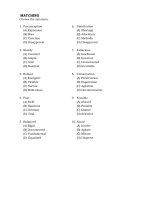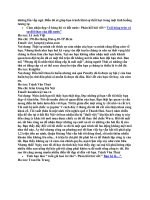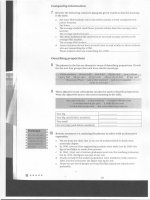Tài liệu Opportunities in technical writing careers part 9 ppt
Bạn đang xem bản rút gọn của tài liệu. Xem và tải ngay bản đầy đủ của tài liệu tại đây (92.71 KB, 10 trang )
tion already in existence (development reports, test procedures, and
instruction books on similar equipment). If possible, obtain the
equipment for further study.
2. Meet with the project engineer and other responsible per-
sonnel to obtain additional data.
3. Based on information from steps 1 and 2, review the prelim-
inary outline and list of illustrations. Revise this preliminary out-
line to make a working outline.
4. Deliver the list of required illustrations to the illustration sec-
tion and discuss how they will be produced.
5. Begin writing the instruction book. During the writing pro-
cedure, prepare sketches, revise existing production drawings, and
describe requirements for illustrations. Identify illustrations by fig-
ure number and title and forward them to the appropriate illustra-
tion section.
6. As writing continues, check the illustrator’s rough drawings.
7. Make arrangements with the photography section for neces-
sary photographs.
8. Review the completed draft. Edit the copy for technical accu-
racy, format, content, and correct references to illustrations and
paragraphs.
9. Submit corrected draft to the editorial section for prelimi-
nary review.
10. Following conferences with the copyeditor, prepare final
draft and forward it to the editorial section.
11. After receiving the reviewers’ copies of the final draft, check
and incorporate reviewers’ comments into the master copy.
12. Review the manuscript completely, rechecking all illustra-
tion and paragraph references, format, and paragraphing for tech-
nical accuracy.
13. Send the completed manuscript to the editorial section.
Duties of the Technical Writer 71
14. When galley proofs have been received from the printer,
review carefully, correct, and forward the corrected galleys to the
editorial section. The importance of careful proofreading cannot
be overemphasized.
In any publications department that prepares instruction books,
the writer is involved in the following four phases.
1. Research. The writer analyzes the requirements of the
project, collects the preliminary data, examines and
interprets the data, and prepares the outline.
2. Development. In the development stage, the outline
prepared in the research stage is used by the writer as a guide
in writing the text and in determining the illustration
requirements of the first draft.
3. Prototype. The research and development stages produce a
prototype or model of the instruction book.
4. Production. In the production stage, all effort is
concentrated on mechanically producing the book.
These, then, are the specific duties of the manuals writer; but in
terms of procedures, they are fairly representative of any kind of
job the technical writer may tackle.
Proposals
Writing proposals is very important to most manufacturing com-
panies. In general, a contract usually precedes the start of any man-
ufacturing operation. The contract may be between the company
72 Opportunities in Technical Writing Careers
and a government agency, between the manufacturer and a supplier
of parts and materials, or between the manufacturer and the com-
pany that is buying the finished product. A contract proposal is pre-
pared in which the product and the standards to which it is
supposed to adhere are submitted to the purchaser. The two par-
ties to the contract then work out the final purchase terms. Con-
tract proposals probably rank next in number to reports and
manuals.
Government agencies, frequently branches of the military, as well
as private industries and foundations regularly solicit proposals from
suitable companies to conduct research on a particular problem or
to design a mechanism or facility. These requests for proposals
(RFPs) may involve anything from investigating the socioeconomic
impact of a new manufacturing facility through developing new
traffic control patterns. They may even involve the design and man-
ufacture of new military equipment.
Companies responding to RFPs must design proposals, often
several volumes long, which convince the government agency or
industry that their company’s suggested research project or design
best fits their requirements and is worthy of funding. Often these
proposals must be submitted within a short time after receipt of
their request, so expertise in proposal writing is essential.
Proposals may seek funding in the millions of dollars. A com-
pany’s success and its continued existence depend upon having its
proposals accepted and funded. Without funded projects, there is
no new business and no reason for the organization to continue to
exist. Academic research units are in much the same position: with-
out funding obtained through proposals, they cannot continue their
work.
Duties of the Technical Writer 73
In all companies involved with proposal preparation, the tech-
nical writer serves a crucial function, and the ability to write con-
crete, persuasive proposals within tight deadlines is a highly
marketable skill. Later, of course, these same writers may be
involved in the preparation of the report and impact statements
growing out of the research projects.
Regardless of the type of proposal involved, it is a vital element
in all companies, large or small, in government agencies, and in uni-
versities. So, when you read that General Electric or Lawrence Liv-
ermore Laboratory or Lockheed has received grant money, you may
be sure that a proposal writer was involved in obtaining the grant.
Research and Development
Research and development is the starting point of manufacturing;
therefore, there will always be a place for technical writers in pub-
lic and private research institutes. Research reports of all kinds must
be written to provide vital information for product development
and manufacturing.
Government-Sponsored Activities
Opportunities for technical writers are also available with programs
that are sponsored by the governments of the United States and
Canada. Good starting points are the U.S. Department of Defense
and the Canadian Department of National Defence.
As an example, the U.S. Department of Defense maintains a
Defense Technical Information Center (DTIC), which provides
centralized operation of department services for the acquisition,
storage, retrieval, and dissemination of scientific and technical
74 Opportunities in Technical Writing Careers
information to support the department’s research, development,
engineering, and studies programs. Many universities and private
research foundations also have government-sponsored programs.
Additionally, the DTIC reports on all writings that it deems sig-
nificant, even on work that was not government funded. This is a
staggering task. In this country alone, there are thousands of indus-
trial concerns ranging in size from Lockheed Martin to small shops
that manufacture just one or two specialty items.
Employees of DTIC work in one of seven major categories, with
the classification technical information specialist of particular inter-
est to technical writers. The job is described as follows.
Technical information specialists are primarily concerned with the
direction, administration, development, coordination, and per-
formance of work involved in processing and transmitting scien-
tific, technical, or other specialized information. Requires a broad
knowledge of one or more professional, scientific, or technical dis-
ciplines or fields of interest to understand the significance and
relationship of the concepts and ideas contained in the informa-
tion area and a practical knowledge of documentation or library
techniques.
DTIC headquarters is located in Fort Belvoir, Virginia, and there
are five additional locations throughout the country. Visit
www.dtic.mil for complete information on this interesting career
option.
In both Canada and the United States, many of the larger com-
panies that manufacture highly complex machines, such as com-
bat aircraft, computers, and nuclear power plants for submarines,
also maintain huge research laboratories. Written reports on all of
their activities, including ideas for new or modified products, must
be submitted to the government. The organizations that submit
these reports do so not only because they are required to, but also
Duties of the Technical Writer 75
because they hope that this information will lead to new contracts
and revenues.
Trade Journals and House Organs
Almost every technical, commercial, and trade organization, and
business association, no matter how small, publishes a monthly
magazine that contains material of interest to its members. The arti-
cles included may discuss such subjects as the effects of crime, tax
laws, or new marketing techniques on business.
Every company that has publicly traded stock issues an annual
report to its stockholders. Some of these reports are magnificent
beyond imagination and are often a staggering twenty pages long.
A lot of work, money, and effort are expended in preparing these
annual reports, which are intended not only to inform but to
impress the reader.
Many large companies also publish and distribute house organs
(technical magazines the companies produce) to their stockholders
and libraries. An example is The Lamp, published by the Exxon-
Mobil Corporation. This magazine presents articles in a narrative
form about its far-flung operations, new technology it is adopting,
its research projects, and its pro bono activities. These magazines
are printed to present a favorable image of the company.
Special Projects
The wide variety of industrial concerns has created a need for spe-
cial project writers. The vast field of research depends on the inter-
change of ideas, and because of this, many companies encourage
their engineers and scientists to write papers for presentation at con-
76 Opportunities in Technical Writing Careers
ferences and seminars. The preparation of a paper is a very time-
consuming process.
Some companies, particularly those with large research staffs,
have a technical publications department whose function is to assist
employees in preparing and presenting papers. The writers may use
report drafts to write the entire paper, subject to editing by the pre-
senter. Graphs, photographs, and digital images are often an inte-
gral part of the presentation. In addition, the writer may coach the
presenter in delivering the talk if he or she is shy or a novice public
speaker. Many executives now employ technical writers as special
assistants. By combining a flair for writing with a sound scientific
background, these assistants help top management officials by writ-
ing progress reports for them or reviewing their speeches.
With the continuous introduction of new technology, the com-
munications field is an ever-changing and expanding field. Tech-
nical writers will be preparing lectures and instructions to be
delivered from DVDs, developing programs for data storage and
retrieval systems, and performing a multitude of other communi-
cations jobs too numerous to mention. To succeed, the writer must
be able to learn new communications and computer techniques as
they occur.
Technical Reports
Technical reports are found in any library, especially those in uni-
versities and government installations that conduct research. The
number of these reports on file throughout the world is staggering
and requires advanced storage and retrieval systems to reduce the
space that all of this written material requires and to make it more
accessible to users.
Duties of the Technical Writer 77
Technical reports represent a very large part of an organization’s
publication output. They also represent a great amount of the time
devoted by many technical writers and editors.
A final report is usually preceded by a series of progress reports,
which are short documents indicating what has been accomplished
at stated intervals and submitted to the contracting agency. Some-
times a technical writer helps with this work; at other times it is
done entirely by the researchers. If the project is complicated and
takes a long time to complete, a periodic report is written that con-
solidates a number of individual progress reports. The periodic
report also may be edited by a technical writer. A technical editor
will work on the project once the material submitted by the scien-
tists is put together into a report. For example, the National Air and
Space Administration (NASA) spells out certain specifications for
the format of its reports. This format must be checked by the edi-
tor, along with grammar, punctuation, and other stylistic features.
Report writing is one of the main categories of technical writ-
ing. As technology matures and as companies continue to grow, the
volume of records and communications also grows. Reports are the
usual method for many of the larger companies to coordinate their
various activities, especially if research is a primary occupation. The
publications department will be responsible for the reporting, and
a technical editor will be assigned to supervise the undertaking.
Some engineering and scientific organizations exist primarily for
testing, research, and experimentation. Their main product is not
the manufacturing of goods, but the production of reports and
papers describing research procedures and results. In this endeavor,
the technical writer is as necessary as the researcher.
There are many kinds of reports, depending on who will use the
information being reported. External reports go outside the com-
78 Opportunities in Technical Writing Careers
pany to clients, government bureaus, and libraries. They become
the basis for further research. Internal reports are written solely for
use within the company. They may be service reports, progress
reports, and maintenance reports, to name only a few.
The reporting skill of the technical writer is important to most
technical fields because reporting is basic to the success of the enter-
prise. The techniques of reporting are the foundation of instruc-
tion books, technical papers, and various forms of promotion and
publicity.
A basic approach to technical writing is suggested by Matt Young
in The Technical Writer’s Handbook. In his preface he states: “It
would be very easy to show how technical or report writing differed
from other writing. My purpose, however, is to stress the similari-
ties. Writing is for communication.” Along these lines, he presents
a few simple rules.
1. Write the way you talk; then polish.
2. Be explicit.
3. Write for the uninformed reader.
He continues by stating, “Many technical writers, unfortunately,
seem to forget that their intention is to communicate, and they
write as if for themselves. Their papers are insufficiently explana-
tory, and they are written with little or no regard for style or clar-
ity. . . .” Even relatively good technical writing is frequently
characterized by long, complicated sentences and difficult prose.
Young even points out that important papers may be ignored
because no one can understand them, so the work about which they
are written remains to be discovered independently by someone
else!
Duties of the Technical Writer 79
Audiovisual Scriptwriting
You might not realize that technical writers can work in scriptwrit-
ing, but they are important contributors to training, instructional,
and documentary films. And while many technical writers remain
anonymous, those working in scriptwriting generally receive credit
along with everyone else who worked on the project.
In general, these projects are produced by private film and tele-
vision studios or even by large companies that have their own pro-
duction facilities. The films and tapes are broadcast by private or
public television stations. Some films, such as the Civil War docu-
mentary by Ken Burns, are so well done that they attain widespread
fame.
Training Films
Audiovisual productions cover a wide range of topics. They are used
for training personnel in industry, hospitals, and the armed forces.
Private companies produce films that are distributed to their cus-
tomers to teach their personnel how to install and operate newly
purchased equipment. Schools use disks, tapes, and films for
instructional purposes. Audiovisual presentations are popular at all
educational levels from elementary through graduate school and for
adult education.
The most popular method of training had long been the video,
but that has now been largely replaced by the DVD because of its
effectiveness in holding the viewer’s attention. As a technical writer
working on such a project, you need to remember that the DVD
must complement the printed material so that it becomes a visual
aid to encourage the viewers to think about what they have just
seen. Also, consider how the visual presentation will provide the
80 Opportunities in Technical Writing Careers









